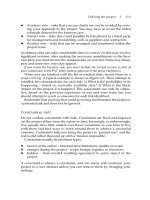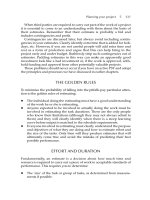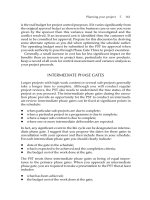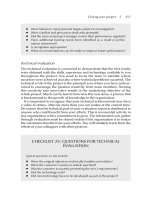Management a practical introduction 3rd kinicky chapter 09
Bạn đang xem bản rút gọn của tài liệu. Xem và tải ngay bản đầy đủ của tài liệu tại đây (245.37 KB, 38 trang )
Management
A Practical Introduction
Third Edition
Angelo Kinicki &
Brian K. Williams
Kinicki/Williams, Management: A Practical Introduction 3e ©2008, McGraw-Hill/Irwin
Chapter 9: Human Resource Management
Getting the Right People
for Managerial Success
Strategic human resource management
The legal requirements
Recruitment & selection
Orientation, training, & development
Performance appraisal
Compensation & benefits
Promotions, transfers, disciplining, & dismissals
Kinicki/Williams, Management: A Practical Introduction 3e ©2008, McGraw-Hill/Irwin
9.1 Strategic Human
Resource Management
HOW DO MANAGERS MANAGE THEIR MOST
IMPORTANT RESOURCE?
The activities managers perform to plan for, attract,
develop, and retain an effective workforce is human
resource management
The economic or productive potential of employee
knowledge and actions is human capital
Human capital is now seen as being important to a
company’s competitive advantage
The economic or productive potential of strong, trusting,
and cooperative relationships is called social capital
Kinicki/Williams, Management: A Practical Introduction 3e ©2008, McGraw-Hill/Irwin
Two Important HR Concepts
Human Capital: the
economic or productive
potential of employee
knowledge.
Highly educated,
knowledgeable workers
are the hardest to find
and the easiest to loose.
“smart people gap”
McGraw-Hill/Irwin
Social Capital: the
economic or productive
potential of strong,
trusting and cooperative
relationships.
This includes goodwill,
mutual respect, trust, and
cooperative relationships.
Good relationships within
an organization outrank
many other factors in
importance for employees
Kinicki/Williams, Management: A Practical Introduction
3eMcGraw-Hill
©2008, McGraw-Hill/Irwin
© 2006 The
Companies, Inc. All rights reserved.
9.1 Strategic Human
Resource Management
Figure 9.1: The Strategic
Human Resource
Management Process
Kinicki/Williams, Management: A Practical Introduction 3e ©2008, McGraw-Hill/Irwin
9.1 Strategic Human
Resource Management
Predicting future employee needs means that
the manager needs a good understanding of what
personnel the organization might need and likely
sources for the personnel
Managers should assume that the organization
will change, and so then will staffing needs, and
that personnel might come from inside or outside
the firm
Some companies create a human resource
inventory (tracks employees by name, education,
training, languages, and other important
information) which is used when considering
inside employees for new positions
Kinicki/Williams, Management: A Practical Introduction 3e ©2008, McGraw-Hill/Irwin
9.1 Strategic Human
Resource Management
Companies that engage in strategic human resources
planning develop a systematic, comprehensive strategy
for understanding current employee needs and predicting
future employee needs
Because companies need to understand the current
employee situation before they can plan for the future,
they do a job analysis (determine, by observation and
analysis, the basic elements of a job) and write a job
description (summary of what the holder of the job does
and why), and a job specification (description of the
minimum qualifications a person must have to do a job
successfully)
Kinicki/Williams, Management: A Practical Introduction 3e ©2008, McGraw-Hill/Irwin
9.2 The Legal Requirements Of
Human Resource Management
WHAT LEGAL ISSUES DO MANAGERS NEED TO
BE AWARE OF?
Managers need to be familiar with laws related to:
1. Labor relations – especially laws relating to
unions
2. Compensation & benefits - the Fair Labor
Standards Act of 1938 established minimum living
standards for workers engaged in interstate
commerce, including provision of a federal
minimum wage
Kinicki/Williams, Management: A Practical Introduction 3e ©2008, McGraw-Hill/Irwin
Determining HR Needs
1. Prepare HR Inventory
2. Prepare Job Analysis
a) Job Description
Objectives of job
Type of work
Duties & responsibilities
b) Job Specifications
Min qualifications
required
McGraw-Hill/Irwin
3. Assess Future Demand
4. Assess Future Supply
5. Establish Strategic
Plan
recruiting, selecting,
training, developing,
appraising,
compensating, etc.
Kinicki/Williams, Management: A Practical Introduction
3eMcGraw-Hill
©2008, McGraw-Hill/Irwin
© 2006 The
Companies, Inc. All rights reserved.
9.2 The Legal Requirements Of
Human Resource Management
3. Health & safety - there is a growing body of law
designed to protect employees from hazardous work
conditions
4. Equal employment opportunity - the Equal Employment
Opportunity Commission covers discrimination,
affirmative action, and sexual harassment
-discrimination occurs when people are hired or
promoted (or denied hiring or promotion) for reasons not
relevant to the job
-affirmative action focuses on achieving equality of
opportunity within an organization
-sexual harassment consists of unwanted sexual
attention that creates an adverse work environment
Kinicki/Williams, Management: A Practical Introduction 3e ©2008, McGraw-Hill/Irwin
9.3 Recruitment & Selection: Putting
The Right People Into The Right Jobs
HOW DO MANAGERS CHOOSE THE BEST
PERSON FOR A JOB?
The process of locating and attracting qualified
applicants for jobs open in the organization is
referred to as recruitment
There are two types of recruitment: internal and
external
Kinicki/Williams, Management: A Practical Introduction 3e ©2008, McGraw-Hill/Irwin
9.3 Recruitment & Selection: Putting
The Right People Into The Right Jobs
1. Making people already employed by the
organization aware of job openings is called
internal recruiting
Companies use job postings where information
about job vacancies and qualifications is posted
on bulletin boards, in newsletters, and on the
organization’s intranet to find internal personnel
2. Attracting job applicants from outside the
organization is external recruiting
The most effective source of external
employees is referrals
Kinicki/Williams, Management: A Practical Introduction 3e ©2008, McGraw-Hill/Irwin
Internal Recruiting:
Advantages/Disadvantages
Advantages:
Employees tend to be
inspired to greater effort
and loyalty
The whole process of
advertising, interviewing,
and so on is cheaper
There are fewer risks.
Internal candidates are
already known and are
familiar with the
organization
McGraw-Hill/Irwin
Disadvantages:
Restricts the competition for
positions and limits the pool
of fresh talent and
viewpoints
It may encourage
employees to assume that
longevity and seniority will
automatically result in
promotion
Whenever a job is filled, it
creates a vacancy
elsewhere in the
organization
Kinicki/Williams, Management: A Practical Introduction
3eMcGraw-Hill
©2008, McGraw-Hill/Irwin
© 2006 The
Companies, Inc. All rights reserved.
External Recruiting:
Advantages/Disadvantages
Advantages:
Applicants have
specialized knowledge
and experience
Applicants have fresh
viewpoints
McGraw-Hill/Irwin
Disadvantages:
The recruitment
process is longer and
more expensive
The risks are higher
because the persons
hired are less well
known
Kinicki/Williams, Management: A Practical Introduction
3eMcGraw-Hill
©2008, McGraw-Hill/Irwin
© 2006 The
Companies, Inc. All rights reserved.
9.3 Recruitment & Selection: Putting
The Right People Into The Right Jobs
Because people are often disillusioned after
taking a job, some companies provide realistic
job previews where candidates are given both
positive and negative features of the jobs and the
organization before being hired
The process of screening job applicants and
hiring the best candidate is the selection process
There are three types of selection tools:
background information, interviewing, and
employment tests
Kinicki/Williams, Management: A Practical Introduction 3e ©2008, McGraw-Hill/Irwin
9.3 Recruitment & Selection: Putting
The Right People Into The Right Jobs
1. Background Information - application forms
and resumes are basic sources of information
about job applicants
2. Interviewing - can be unstructured (asks
probing questions to find out what the applicant
is like), or structured (asks each applicant the
same questions and compares responses to a
standardized set of answers)
Kinicki/Williams, Management: A Practical Introduction 3e ©2008, McGraw-Hill/Irwin
9.3 Recruitment & Selection: Putting
The Right People Into The Right Jobs
3. Employment Tests - legally considered to consist
of any procedure used in the employment selection
decision process
Three common employment tests are:
-ability tests - measure physical abilities, strength,
stamina, and so on
-performance tests - measure performance on
actual job tasks
-personality tests - measure personality traits like
adjustment, energy, sociability, independence, and
so on using tests like the Myers-Briggs assessment
Kinicki/Williams, Management: A Practical Introduction 3e ©2008, McGraw-Hill/Irwin
9.4 Orientation, Training, & Development
HOW DO MANAGERS HELP NEW HIRES BE
SUCCESSFUL?
Helping newcomers fit smoothly into the job
and the organization is referred as orientation
Orientation should provide information on:
-the job routine
-the organization’s mission and operations
-the organization’s work rules and employee
benefits
Kinicki/Williams, Management: A Practical Introduction 3e ©2008, McGraw-Hill/Irwin
9.4 Orientation, Training, & Development
Managers can also improve employee
performance by providing training and development
Training refers to educating technical and
operational employees in how to better do their
current jobs
• Short-Term skills oriented
Development refers to educating professionals
and managers in the skills they need to do their
jobs in the future
• Long-Term career oriented
Kinicki/Williams, Management: A Practical Introduction 3e ©2008, McGraw-Hill/Irwin
Typical Areas for Which Employee
Training and Development are Given
Communications
Computer skills
Customer service
Diversity
Ethics
Human relations
Quality initiatives
Safety
Sexual harassment
McGraw-Hill/Irwin
Kinicki/Williams, Management: A Practical Introduction
3eMcGraw-Hill
©2008, McGraw-Hill/Irwin
© 2006 The
Companies, Inc. All rights reserved.
On-the-Job and Off-the-Job
Training Methods
On-the-Job
Methods
Off-the-Job
Methods
1) Coaching—a subordinate is
taken under the wing of an
experienced employee
1) Classroom programs—used by
91% of companies
2) Training positions—trainees are
given positions as assistants to
experienced managers
3) Job rotation—employees are
given lateral transfers to allow
them to work at different jobs
4) Planned work activities—
trainees are given important
work assignments
McGraw-Hill/Irwin
2) Videotapes—used by 79%
3) Workbooks or manuals—77%
4) Overhead/opaque
transparencies—56%
5) Business books—55%
6) Role playing—55%
7) Other: audiotapes, self-testing
instruments, case studies,
slides
Kinicki/Williams, Management: A Practical Introduction
3eMcGraw-Hill
©2008, McGraw-Hill/Irwin
© 2006 The
Companies, Inc. All rights reserved.
9.4 Orientation, Training, & Development
Figure: 9.2: Five Steps in the Training Process
Kinicki/Williams, Management: A Practical Introduction 3e ©2008, McGraw-Hill/Irwin
9.4 Orientation, Training, & Development
Training that takes place at work is called onthe-job-training
Training that takes place using classroom
programs, videotapes, and so on is off-the-job
training
When computers are used to provide additional
help or reduce instructional time, there is
computer-assisted instruction
Kinicki/Williams, Management: A Practical Introduction 3e ©2008, McGraw-Hill/Irwin
9.5 Performance Appraisal
HOW SHOULD MANAGERS ASSESS THEIR
EMPLOYEE’S PERFORMANCE?
Performance appraisal consists of assessing
an employee’s performance and providing him or
her with feedback
This provides employees with an
understanding of how they are doing relative to
the firm’s objectives and it helps with their
development and training
Kinicki/Williams, Management: A Practical Introduction 3e ©2008, McGraw-Hill/Irwin
9.5 Performance Appraisal
There are two types of appraisals:
1. Objective appraisals are based on facts and are often
numerical
2. Subjective appraisals are based on a manager’s
perceptions of an employee’s traits (attitudes, initiative,
leadership) or behaviors (specific observable aspects of
performance)
Most performance appraisals are done by managers,
but sometimes information comes from other sources like
peers and subordinates
Kinicki/Williams, Management: A Practical Introduction 3e ©2008, McGraw-Hill/Irwin









